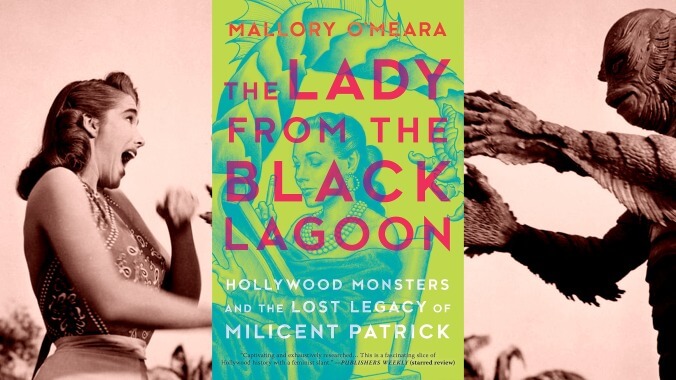A love for its subject can’t clear the murky waters of The Lady From The Black Lagoon


For decades, pioneering special-effects makeup artist Milicent Patrick was little more than a beaming enigma, a striking woman posing with a sketch pad in promotional photos from film studios for whom reducing talented women to sexualized objects was second nature. Recently, the true nature of her accomplishments has, finally, come to the fore, and Patrick has been properly credited for her masterwork: the design for the iconic Gill-man suit in the Universal monster classic The Creature From The Black Lagoon (1954). But thanks in part to the spiteful efforts of her jealous boss, Universal makeup department head Bud Westmore, what little information that was available about Patrick’s work has disintegrated like so much crumbling latex foam.
Enter Milicent Patrick devotee Mallory O’Meara, who sets out to write the first biography of her monster-movie idol with a near religious devotion. O’Meara’s personality shines through the pages of The Lady From The Black Lagoon: Hollywood Monsters And The Lost Legacy Of Milicent Patrick, and honestly, she seems like a lovely person. She’s empathetic, she’s humble but not a pushover, and she speaks very highly of the many friends she mentions throughout the book. But that doesn’t change the fact that, if you’re looking for a book about Milicent Patrick, this isn’t really that. In fact, for much of its 350 pages, it’s a book about Mallory O’Meara.
O’Meara is not a historian, as she makes clear with frequent, unintentionally damning asides like a joke about how the Hays code banned depictions of “white slavery (but other kinds of slavery were cool),” implying that O’Meara is not aware that “white slavery” is an early-20th-century term for what’s now referred to as sex trafficking. (A confusingly written passage saying that 1953’s It Came From Outer Space “started a cinema trend” of “this new sci-fi thing” is similarly ahistorical.) Adult readers with an interest in film history—that is, the target audience for this book—will likely find O’Meara’s wide-eyed explanations of things like what The Lone Ranger is, or who William Randolph Hearst was, or that Hollywood is a neighborhood as well as a shorthand for the American film industry, maddening.
These are not the only obstacles on the path to getting to know Milicent Patrick. There’s also O’Meara’s first-person chronicling of her thought process while writing the book, a technique that outbalances actual information about Patrick’s life for the first 200 pages. This begins with the first chapter, which is about how O’Meara, a self-professed producer and screenwriter, stumbled into writing a historical biography after a literary agent friend saw her Milicent Patrick tattoo at a party. Some of the personal anecdotes in the book are relevant and important, like O’Meara’s experiences with sexual harassment on film sets. But most are filler, like a two-page aside about how she met her current partner, and her dutiful scene-setting every time she visits a new library or archive.
A basic rule of nonfiction writing is that, unless it’s a personal essay, you, the writer, are not the subject of the story. Writing is not an inherently interesting activity; for the most part, it’s incredibly dull. This is O’Meara’s first book, and many nonfiction writers struggle with reframing their work outside of the personal essay format when they’re starting out. But for the only biography ever written about someone the author idolizes, almost to a fault, structuring the book around the author, and her obsession, and her research, and her experiences, and her alternative style, and how dark chapters in Patrick’s life make her feel—O’Meara skims so lightly over a pair of deaths by suicide in Patrick’s life that she ends up coming off as insensitive, flippantly referring to them as “theatrics” late in the book—it’s an odd choice.
This storytelling crutch also makes the factual substance of the book difficult to follow, as O’Meara’s charting of her process doesn’t always fit in neatly with the arc of Patrick’s life, and the former usually ends up outshining the latter when the two diverge. This becomes especially frustrating late in the book. The Lady From The Black Lagoon is so front-loaded with personal anecdotes that it arouses suspicion that O’Meara didn’t find enough information about Patrick for an entire book, but finished it the best she could anyway. Then, it’s revealed that Patrick’s niece gave O’Meara access to more than 800 items of Patrick’s personal effects that answered all the unanswered questions about Patrick’s life that O’Meara has been wistfully bemoaning the entire book. A twist ending might be compelling in a screenplay, but it’s a waste of time in a work of history.
It’s important to note that O’Meara, for all her glib oversharing on other subjects, is an expert on the film The Creature From The Black Lagoon. And The Lady From The Black Lagoon is an engrossing read when we finally get down to the subjects of special-effects movie makeup and the behind-the-scenes power struggles that led to Patrick’s name being erased from the historical record for so many years. The problem is, this doesn’t happen until 200 pages in, and isn’t analyzed in much deeper detail than O’Meara’s assertion that Bud Westmore was an asshole. (Which he was, but still.) She also seems to be on a dogged quest to prove that Patrick wasn’t just someone’s girlfriend hanging around set—a line of thinking that’s brought up multiple times, but that doesn’t have to be proven to someone who would take the time to purchase and read a book about her.
In the end, it’s not clear who O’Meara’s audience is for The Lady From The Black Lagoon besides herself, which may be forgivable in a debut but frustratingly below the level of similar works of feminist film history published this decade. If you have a teenage girl in your life who’s interested in movie monsters and/or film history—or if you yourself don’t know much about either—The Lady From The Black Lagoon is an entertaining introduction to those subjects, written in a breezy pop-feminist blog style. It might even inspire that teenage girl you know to become a writer when she grows up. But if you’re thinking of fitting this one in after you’re finished with, say, Karina Longworth’s latest, you may find these to be shallow waters indeed.